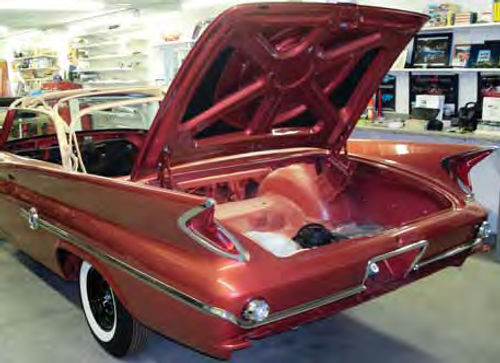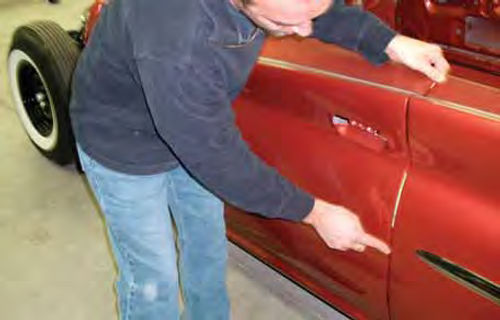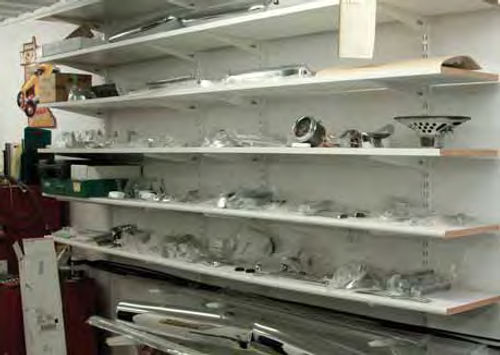How -to I Was a Teenage Restoration Pro
Jerry Kopecky Got Into the Business Before His 20th Birthday. Here Are Some Things He’s Learned Since Then.
WHAT ARE THE “real world” possibilities for a young person who wants to find work or open a business in the auto restoration field?
To help in answering those questions, we talked with Jerry Kopecky, a Wisconsin restoration pro who started as a teenager and has stayed in the business for two decades.
Kopecky, who turns 40 this year, restores old cars—specifically finned Chrysler models—that were built 10-15 years before he was born. In fact, in January 2007 Kopecky gained national notice in the hobby when a bright red ’59 De Soto convertible that he spent a year restoring sold for $285,000 at a Barrett Jackson auction. Kopecky now specializes in “high-end” tail-finned Mopars made in 1955-61 and does only complete every-nut-and-bolt restorations on some very rare cars.
Here are some of his comments:
How did you get “into” these cars and why do you like them?
It happened purely by accident.
Actually, I started when I was 19 and I’m in my 20th year of working as a restoration professional. For 18 of those years we (my dad and I) had the luxury of restoring cars for the same customer. That was Jess Ruffalo, a well-known car collector from Plainfield, Wisconsin.
In the late ’80s he started to gain affection for these finned Mopars—and that was about the time that I started restoring cars professionally.
Prior to that, Jess was into big-block ’Vettes and Mustangs and all the cars I had grown up with and wanted to restore at that time. And so, I was just getting into the business at the time he was getting out of those cars I liked and into the finned Mopars.
• Let’s back up. Your dad was a restorer,so did you ever work with him?
Yeah! Oh yeah! I grew up around a shop that dad had right in the downtown area of our village. When I started my apprenticeship, it was in the fall of 1989, Jess brought in a ’59 Dodge Coronet. As luck would have it, he decided to paint it two-tone pink and I absolutely hated it. That car almost made me go back to college, because that’s how much I hated working on that car!
• And now you own that car (seen on this month’s cover), don’t you?
And now I own it. Yeah. I must admit that when that car was done, it lit the spark. I could see the reactions from the people who said, “I’ve never seen that (kind of) car before” or “I haven’t seen one in umpteen years!” There Was a lot of excitement.And then we went to a De Soto Fireflite after that and then a Chrysler New Yorker convertible and on and on and on. And it didn’t take me very long to see what Jesswasup to.Whenhepassed away in 2007 he had the largest collection of finned Mopars in the world. They (the Ruffalo family) had 35 of them.
• Tell us about the ’59 De Soto convertible you did in 2005-06 and took to Barrett-Jackson to sell.
It was a ’59 De Soto Firesweep convertible—the lowest trim level car (with Adventurer being the highest trim level). Firesweep was the plainest De Soto convertible, but one factor that helped immensely was that the car had just 3200 original miles on it. It had been stored for almost 50 years, so it was in pretty rough condition. That’s why we did a complete, body-off-frame, every-nut-and bolt restoration on that car.
We took it to the Barrett-Jackson Auction in Scottsdale in January 2007 and our highest hopes—or plan—was to secure $150,000 for it. We had $130,000 in the restoration. Earlier that night a ’59 Adventurer convertible sold for a record $230,000, which pretty much shocked the finned Mopar world. Then, we followed up an hour later with our ’59 De Soto Firesweep and it sold for $285,000 and the rest is history for my shop.
• So, why do you like these cars on a personal level?
I like them first because they’re rare. If you have one of these cars—it doesn’t matter which make, Chrysler, De Soto, Dodge or Plymouth from this era— chances are, if you go to a show you’re going to be the only one there with such a car. Take the Chrysler 300F convertible I’m working on now. They made 248 of them in 1960 and there’s less than 60 known to exist.


• How long does it take to do an every-nut-and-bolt restoration? How long have you been working on the Chrysler 300F convertible, for example.
We have been working on the 300F for a year and a half now and we’ll have it done this spring. So it will take a full two years to complete.
• As you moved to a concentration on more-rare cars, what changes took place in your shop?
What happened was that, when the values of the cars went up, it was warranted to spend the money that would bring the cars to that next level. When we did a restoration 20 years ago it was kind of “El Cheapo!” By that, I mean quality work, but no frills. We didn’t “fit” sheet metal back then. The cars were what they were. We did nice bodywork and paint, good chrome and upholstery, but that was about it. And now, we’ve evolved over the years.
• Let’s talk about the fitting of the sheet metal.
Most of the high-end shops do it. We developed it because I also had a frame straightening shop on the side here for 15 years.I honed my fitting skills by working on modern vehicles and, of course, that spills over into the classics. I personally became obsessed with gaps and lines and fits (between body parts). And I thought, “There’s no reason you can’t make one of these old boats fit like a new car.” (Kopecky said he re-works the margins around the edges of body panels up to six or seven times per car to get a perfect panel fit.)
• Which is harder to do—a modern car or an older car? With the older car you have body-on-frame construction rather than a platform with an integrated body structure. Is it easier to get the vintage body-and-frame cars perfect?
Yes, the modern cars are harder to fix. It is easier to do an older car and they are more fun to work on, too.
• So, what about the cars you’re restoring, most of which have Chrysler’s early unitized body construction?
Now, those we can bring back to absolute original condition. We strive for that by making our metal work a good platform to start with. In other words, we recreate every rib and detail that was in the original floor stampings and anything structural. We duplicate everything exactly like it was when new so that, structurally, it will be as sound as it once was and cosmetically it will be the same as new, too.
• OK. So, you’re this high-end car restorer, but there’s a lot of hobbyists out there working in home shops, with less money and equipment. What practical tips can you give them?
You can’t believe the wide range of the questions I get from home restorers, but if you had to boil it all down to what’s the biggest thing, it’s the metal work. Most young restorers and even veterans working at home are very unfamiliar with metal work and welding and all that Second is paint.I get a lot of questions on paint. “What kind of paint should I use?” and “What processes do you use to paint?” All of that stuff The best recommendation I can give to other restorers concerns how to start. Everybody gets excited when they get a new project car. I’m guilty of rushing and the guy doing his first car is even guiltier of this. You feel that the first thing you want to do is tear into that car and take it apart and just get into it. But my helper Kevin Dombrowski and I have learned to do just the opposite.We take the interior out, and then we spend time fitting the doors, the panels, the fenders, the hood and the deck lid. All those components are fitted over and over. We take them off and put them back on. In other words, the best tip I have for anybody is to spend the time fitting that car together to make sure everything is the way you want it to be BEFORE you go into body and paint.
I have more restorers come up to me and say, “This door wasn’t right when I gotitandit’sstillnotright.”Well,it’snot right ‘cause you just took it off and painted it and put it back on and what needed to happen is that you had to open the holes around the hinges just a little bit for a better fit.
• You say you get a lot of questions about paint? What tips can you give us?
One thing I’ve learned about paint, and this is more from other peoples’ experiences, is that the brand you use is important. We usePPGandhavealwaysstuckwithPPG’s premium line. There’s a lot of cheaper, more inferior paints available.PPG even has its own economy line. A gallon of PPG’s premium paint is 300 bucks. And you can get a version of it for $100, mixed, CATALYZED and everything. Well, if you buy the cheap product, it makes a difference, especially in longevity. I find that most of the cheap stuff actually looks fantastic when it’s first used; it looks as good as ours. But, a year or two later, it gets apparent that it’s not the same. They have a lot of problems and shrink out, etc.
• You try to save as much of the original hardware as possible when you disassemble a car, and then have it all cadmium plated. What’s The advantage of that approach?
The original hardware, if it’s salvageable, gives a better fit and looks correct. If you send a bunch of it to the cad plater at once, it doesn’t cost much to have it done. And, in case you’re wondering, the plater compensates for the finish so the fit stays good. However, I’m real glad you brought up cad-plated hardware, because you’ll notice there’s not as much of it used on the 300F. Using cad-plated fasteners was one of our tricks when doing the De Soto for Barrett-Jackson. De Sotos are so rare all the restoration details have not been documented and the cad-plated stuff looked great. However, in the 300 world everything is documented. These guys are like Corvette restorers—everything has to be just by the book. So, you’ll see that most fasteners on this car are painted body color. The only cad fasteners we used were on the suspension parts, where cad plated fasteners were originally used.

• What are your thoughts regarding powder coating?
Powder coating has gotten so popular now that almost everyone I talk to does it. It’s not original and, personally, I think you can’t get the look you need. It certainly doesn’t achieve the look we are going for here. Furthermore, you can’t sand it and you can’t buff it. You can’t “work” it when it’s done. Now, I know a lot of guys who take a frame and have it powder coated because they’re doing a driver. That’s fine—and actually pretty good, because it’s something durable against chipping and such. So, I don’t have anything against it as long as it’s done in the right spots.
• Your whole shop is devoted to just one car at a time. Is that an approach you recommend?
You can only work on one car at a time and you really have to have enough room. Also, you have to stay ORGANIZED. I know that all the chrome and bright work for this car is on one group of shelves. I’ve got all the parts for the car grouped like that. Even the interior parts are grouped. This is a complicated interior with four bucket seats, a console and all that, and it couldn’t be restored without great ORGANIZATION.
• You have several books and sets of photocopies handy. How important are they and where do you get them?
What you see in my “paperwork” are wiring schematics and other things. There’s a drawing of how the Mirrormatic mirror works and a schematic for those little high-beam dimmers—GM called them Autronic Eyes, but Chrysler had one called a Scanner. I find this literature here and there, at swap meets and online.
My customer wanted every option on his 300F so he bought four sets of those scanners on eBay for $350 each. They were listed as NOS parts, but they’re not NOS. You can tell they were already on a car. There was black dirt built up. The knobs were all worn and you could see where they had been adjusted. So I just sanded the plastic bodies down, buffed them with a mini buffer and made them look new. There’s a series of lenses inside, so I took them all apart and restored it all. That’s the CRAZY details tuff I like to do.
• You’ve spent nearly half your life doing this work. You’ve tried frame straightening and came back to restoration. What do you think the future holds?
Well, right now it’s not the greatest economy. I need customers who will make a commitment and stay with it until the end and I do occasionally get feedback about the time it takes and the cost. I just videotape and photograph everything I do and I tell the customer that you have to stick in until the end if you want a perfect car
You just have to pay attention to every detail. But, I’m in this for the long run and I’ve learned that it pays off to work this way.
Resource
Kopecky’s Klassics
















